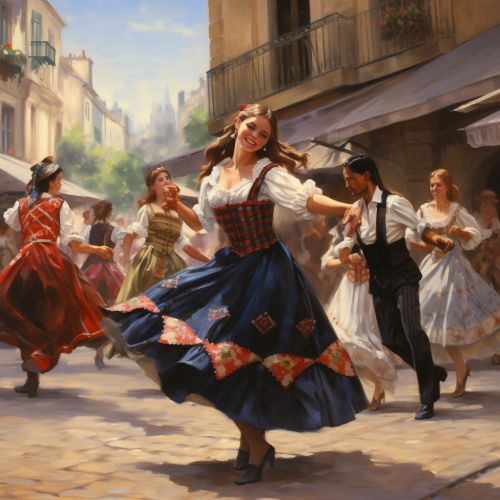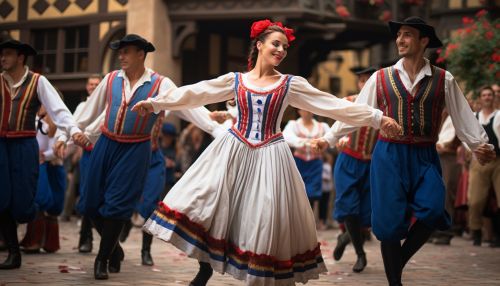Bourrée
Origins and History
The Bourrée is a dance of French origin, often associated with the regions of Auvergne and Limousin. It is a social dance that was popular in courtly society and has been incorporated into larger works of music by notable composers such as Johann Sebastian Bach and George Frideric Handel.
The term 'Bourrée' is derived from the French verb 'bourrer', which means 'to stuff'. This refers to the characteristic style of the dance, which involves quick, stuffing steps. The dance was originally performed by the lower classes in the 17th century, but it quickly gained popularity among the nobility.
Characteristics
The Bourrée is characterized by its lively tempo and light, skipping movements. It is typically performed in a quick duple meter, with an emphasis on the second beat. The dance is often accompanied by traditional French folk instruments, such as the bagpipe and hurdy-gurdy.
The dance is usually performed by couples who dance in a line or circle. The dancers perform a series of intricate steps, including hops, skips, and jumps. The steps are often syncopated, giving the dance a lively, energetic feel.
Variations
There are several variations of the Bourrée, each with its own unique characteristics. The most common variations include the Bourrée d'Auvergne, Bourrée de Berry, and Bourrée Limousine.
The Bourrée d'Auvergne is characterized by its rapid, energetic movements. Dancers perform a series of quick hops and jumps, often accompanied by lively, upbeat music.
The Bourrée de Berry is a slower, more graceful version of the dance. It is often performed to a slower tempo, with an emphasis on elegance and poise.
The Bourrée Limousine is a more complex version of the dance, featuring intricate footwork and elaborate choreography. It is often performed by experienced dancers due to its technical difficulty.
Influence on Classical Music
The Bourrée has had a significant influence on classical music. Many notable composers, including Johann Sebastian Bach and George Frideric Handel, have incorporated the dance into their larger works.
Bach's 'Suite in E minor for Lute' (BWV 996) features a Bourrée as its fifth movement. This piece is one of Bach's most famous works and is often performed by guitarists today.
Handel's 'Music for the Royal Fireworks' also features a Bourrée. This piece was composed for a royal celebration and is one of Handel's most popular works.
Contemporary Usage
In contemporary times, the Bourrée is often performed in folk dance festivals and competitions. It is also taught in many dance schools due to its historical significance and technical complexity.
The dance has also been incorporated into modern music. For example, the rock band Jethro Tull released a song titled 'Bourrée' in 1969, which is based on Bach's Bourrée from his Suite in E minor.


